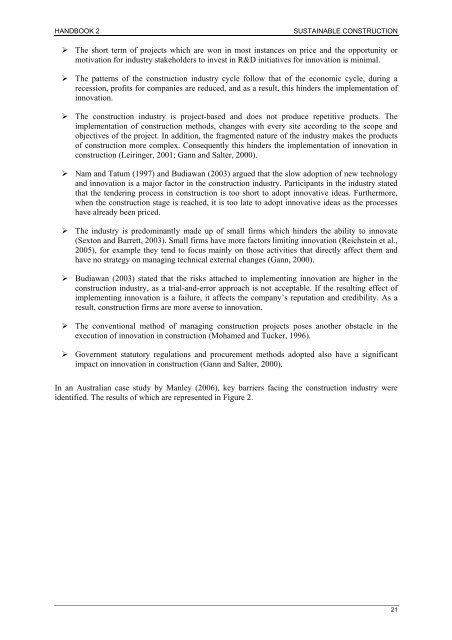Industrialised, Integrated, Intelligent sustainable Construction - I3con
Industrialised, Integrated, Intelligent sustainable Construction - I3con
Industrialised, Integrated, Intelligent sustainable Construction - I3con
Create successful ePaper yourself
Turn your PDF publications into a flip-book with our unique Google optimized e-Paper software.
HANDBOOK 2 SUSTAINABLE CONSTRUCTION<br />
� The short term of projects which are won in most instances on price and the opportunity or<br />
motivation for industry stakeholders to invest in R&D initiatives for innovation is minimal.<br />
� The patterns of the construction industry cycle follow that of the economic cycle, during a<br />
recession, profits for companies are reduced, and as a result, this hinders the implementation of<br />
innovation.<br />
� The construction industry is project-based and does not produce repetitive products. The<br />
implementation of construction methods, changes with every site according to the scope and<br />
objectives of the project. In addition, the fragmented nature of the industry makes the products<br />
of construction more complex. Consequently this hinders the implementation of innovation in<br />
construction (Leiringer, 2001; Gann and Salter, 2000).<br />
� Nam and Tatum (1997) and Budiawan (2003) argued that the slow adoption of new technology<br />
and innovation is a major factor in the construction industry. Participants in the industry stated<br />
that the tendering process in construction is too short to adopt innovative ideas. Furthermore,<br />
when the construction stage is reached, it is too late to adopt innovative ideas as the processes<br />
have already been priced.<br />
� The industry is predominantly made up of small firms which hinders the ability to innovate<br />
(Sexton and Barrett, 2003). Small firms have more factors limiting innovation (Reichstein et al.,<br />
2005), for example they tend to focus mainly on those activities that directly affect them and<br />
have no strategy on managing technical external changes (Gann, 2000).<br />
� Budiawan (2003) stated that the risks attached to implementing innovation are higher in the<br />
construction industry, as a trial-and-error approach is not acceptable. If the resulting effect of<br />
implementing innovation is a failure, it affects the company’s reputation and credibility. As a<br />
result, construction firms are more averse to innovation.<br />
� The conventional method of managing construction projects poses another obstacle in the<br />
execution of innovation in construction (Mohamed and Tucker, 1996).<br />
� Government statutory regulations and procurement methods adopted also have a significant<br />
impact on innovation in construction (Gann and Salter, 2000).<br />
In an Australian case study by Manley (2006), key barriers facing the construction industry were<br />
identified. The results of which are represented in Figure 2.<br />
21






